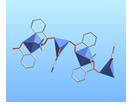 |
|
 |
|
 |
|
 |
|
 |
|
 |
|
 |
|
Chem 130: Structure and Properties of Inorganic Compounds
![]()
Catalog Description
An introduction to structure, bonding and properties of inorganic compounds. Topics covered include basic quantum theory, bonding theories, molecular and solid state structure and periodic properties of the elements and their compounds. Application of these topics to biological, environmental and geological systems will be stressed. The lab will focus on the synthesis of inorganic substances, including simple ionic substances and coordination complexes, and their characterization by UV/Vis and IR spectroscopy.
Course Philosophy
The study of inorganic substances is a rich and interesting discipline that is important for understanding of a variety of other sciences and for an appreciation of the chemistry that is everywhere in our everyday lives. While organic chemistry and biochemistry are typically seen as the chemistry more relevant to living things, the study of inorganic chemistry allows us to understand diverse phenomena such as why we might not want to eat fish from rivers contaminated by mercury compounds, how platinum compounds can work as anticancer drugs, how a catalytic converter makes auto exhaust cleaner, why too much or too little iron can be bad for the body, and why acid mine drainage can cause pollution by heavy metals. Unfortunately, the answers to these interesting questions are not accessible to us immediately but are rather something to work toward as we progress through the course. The ultimate goal of this course is to learn about the properties and reactions of inorganic substances well enough to be able to apply them to understand the many fascinating applications of inorganic chemistry in fields such as geology, medicine, biology, and environmental science. As we gradually learn important core concepts such as atomic structure, spectroscopy, molecular structure and bonding, and reactivity, we will be better able to address these interesting real-world problems. In order to understand the small portion of the complex world of inorganic chemistry that is incorporated into this course, you will need to learn to “think like a chemist.” This will mainly consist of asking (and answering) the kinds of questions that chemists ask about inorganic substances. In your high school courses you may have focused on learning the facts, definitions, and formulas. In this class you will need to understand the “why” behind those facts and definitions and be able to address the “why” in essay type questions. Ultimately you will learn how to apply the concepts to solve more complex problems!
Goals
By the end of the course, students should be able to:
- Recognize and represent inorganic substances using molecular structures, symbols and systematic nomenclature and understand these representations as a chemist would.
- Acquire the language and definitions of inorganic chemistry and be able to apply them.
- Describe and predict atomic structure and periodic properties of atoms and ion based on the periodic table.
- Describe the various models of structure and bonding in covalent, ionic, and metallic substances and use them to predict properties of inorganic compounds and understand how they differ from one another.
- Describe, recognize, and predict the products of the major types of inorganic reactions: acid/base, precipitation, redox, and complexation.
- Appreciate the role that spectroscopy plays in characterizing inorganic substances
- Synthesize information from the above categories to solve more complicated problems
- Appreciate the potential of inorganic chemistry for understanding the world around us and see these real-world problems from the perspective of a chemist.
- Find relevant chemical information in the library or on the internet.
- Develop practical laboratory skills to synthesize and analyze inorganic compounds.
- Use a version of the scientific method to design your own chemical experiments to test hypotheses and interpret the data to understand chemical concepts.
- Express scientific thoughts clearly in written form: in the lab notebook, lab reports, and short writing assignments and essay questions.
| DePauw University | ||||